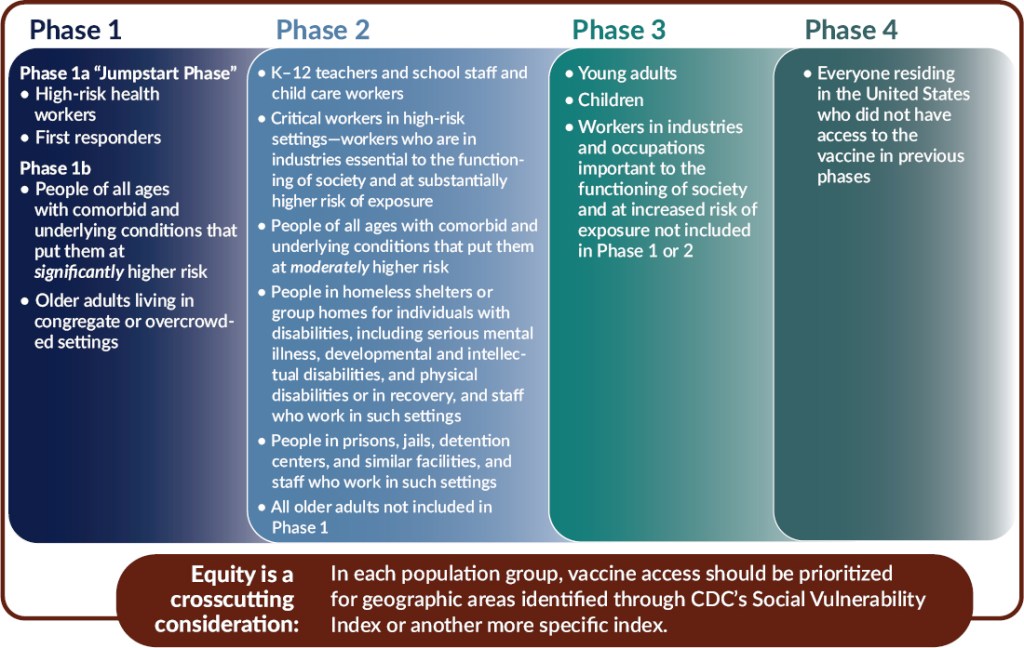With both terrible and wonderful pandemic news on the horizon and the vaccine rolling out (fast) across the US, it’s a good time to answer the big hitter questions about the groundbreaking COVID-19 vaccines.
In the last week of February 2021, the United States marked its 500,000th death from COVID-19. Flags hung half-mast and the President asked us to all stand in a moment of silence at sunset on the evening of February 22nd to honor the many Americans lost to Coronavirus. The profound impact of this pandemic is so momentous it’s often felt to me outrageously overwhelming and hard to even grasp—all at the same time.
Concurrently, COVID-19 infection rates are dropping rapidly, and the COVID-19 vaccine has been applauded as one of many key factors to these truly awesome changes in the United States.
While vaccinations are not solely responsible for helping squash the COVID curve, the immunity achieved from the vaccine (as more and more people become eligible and get those shots in their arms) is a huge contributor to future freedom.
According to the CDC, there has been a five-week plus downward trend in infections with new infection rates dropping a whopping 69% from their peak in January. Additionally, as of mid-February, 1.6 million people per week on average are getting the vaccine with somewhere between 5% and 12% of the United States fully vaccinated, or on their way to full vaccination by the time this article is published (you can read more about these stats here). These numbers are staggering.
As I mentioned, the improvement in cases can’t all be attributed to vaccine administration but this is a huge helper. If you’re interested in reading an article about the multiple contributors as to why numbers are dropping like it’s hot, check out this interesting piece by the Atlantic.
Now, let’s talk about details on the COVID-19 vaccine. This brand new technology and push to get the country vaccinated has many of us excited, lining up without hesitation, practically jumping up and down as we wait while others are more wary, concerned, or hesitant to try this new injectable technology from the get go. Before you jump to any conclusion about how you feel regarding the vaccine I really recommend you do your research!
It’s so easy to get swept away in opinions online these days or get your news solely from social media.
I’ll give you a straightforward, facts-only, review of what we know about the vaccine so far —and what we don’t—in the hopes that this makes your decision clearer. Stay curious my friends and let’s do what I love, and talk science.

Short lesson on immunity.
In order to really understand the way the COVID-19 vaccine (and most vaccines work), it is helpful to have a basic understanding of the immune system. I won’t teach you the ins and outs of immunology in this quick read but I will give you an easy-to-understand breakdown so this article, the COVID-19 vaccine, and basic immune theory clicks in your brain forevermore—I hope! Once you understand the pieces, the whole picture of the immune system really lights up.
In short: your immune system is essentially your body’s built-in ability to recognize itself versus invaders such as viruses or bacterias that don’t belong in the body and relay a defense against any foreign body, bug, or cootie that makes its way in to keep you strong and healthy.
Today we’re going to talk about viruses specifically since COVID-19 is a virus itself. We’ll cruise through initial infection, viral replication, immune response, and where vaccines come into the picture:
-
- The path into the body.
It all begins with an exposure: such as to COVID-19, or the flu, a cold etc. Any invading virus (which is an extremely small particle) fights its way past your nose, mouth, or eyes (A.K.A your mucous membranes which are forms of the immune system themselves) and works its way into your body. This can occur when you forget to wash your hands and pick your nose, someone coughs or sneezes on you, you touch a dirty doorknob and scratch your eye, or whatever that lets viral particles in your body. Maybe you made out with your tinder date during the pandemic, that’s another good way to get COVID-19. The possibilities really are endless. Wash your hands, people! - Cellular attack!
Once a virus gets into your body, it finds a healthy cell of your own to essentially hijack, forcing the cell to help the disease replicate, and oftentimes killing this healthy cell or damaging it in the meantime. Once the virus has replicated, it heads out to find more cells to hijack and take over allowing it to grow within the body. Sometimes your immune system comes in and stops this viral replication before it gets out of control and you never even know you had an exposure—other times the virus is too strong and fast and perhaps your immune system isn’t kickin’ that day and in a short time, many of your healthy cells have been taken over or damaged causing outward signs of infection. This is what’s going on when you’re “coming down with something.” Typically, certain diseases affect certain parts of the body. This is why some bugs are “stomach or GI bugs” and others cause cough, fluid in the lungs, or congestion, such as sinus infections or pneumonia. It all depends on what kind of infection we’re talking about. The COVID-19 virus can affect many parts of the body but typically begins within the respiratory system. - Enter your immune system.
As your body is being attacked by a virus, your immune system perks up its ears and says hey, something isn’t right here! There is a whole complicated response that happens (and it’s sooo cool!) You can read more about this if you want to get nerdy right here my fellow dorks. Essentially, an immune cell called a b-lymphocyte recognizes the disease in your body and secretes something called an antibody. Think about an antibody as a little flag that attaches to viral invaders and invites your immune system to come and attack. Don’t forget the word antibody or what it does—it’s quite an important tidbit when it comes to vaccines and immune response. When your body creates antibodies it essentially exposes the specific virus in question to your immune system which is a systematic, well-oiled army of killer cells and protective responses waiting to attack. So cool! This is why it’s important to take care of your body from day to day, so your immune system army is strong and healthy when and if you ever get sick. - Then what?
Within this complicated immune response (remember we just skimmed it) much of what causes the outward signs of infection such as tiredness, snot, mucous, fever, etc, is actually your body’s immune response to invading disease. Most people have a healthy enough immune system to fight off common viruses and colds… you feel sick for a while, rest, your immune system ramps up, ixnays the virus and eventually you recover. However, some diseases are so strong, scary, and fast-acting, they wreak havoc so great your body isn’t strong enough to fight back, eventually causing permanent organ damage or death. An example of this would be the lasting paralysis caused by Polio or some of the long-term side effects we have seen with COVID-19 virus. - Future immunity and antibodies.
The awesome thing about your immune system is that 99% of the time when you get sick, those antibodies we mentioned earlier—the little warning flags— stick around for life. Hence, next time your body encounters that invading bug that made you super sick, your body can recognize it and say nu-huh hunny, get outta here! Those antibodies that were secreted in your initial injury are already waiting to flag any invading cells before they get to replicate and cause harm. Amazing, right? - Why vaccines help.
The idea behind vaccination is that your body is stimulated in a safe way (safer than getting the actual virus) to create these antibodies. By injecting a small piece of a dead or weakened virus within a vaccine into your body, your immune system is tricked into thinking it’s been invaded by a real virus (an antigen). This creates an immune response and antibodies thus offering protection immediately and in the future.
- The path into the body.
If you’re curious about the different kinds of vaccines we’ve used over time and how vaccines work in general read this right here. You may have heard the words mRNA when talking about the technology behind the COVID-19 vaccine. While the vaccine is new, the technology has actually been studied for a long time and is well understood. Pretty cool. Want to read more about mRNA technology and its journey to success? Check it out here. The newest vaccine to be approved by Johnson and Johnson uses another new vaccine technology called viral vector. You can check out more about viral vector vaccines here. I’ll also give you a quick breakdown of how these vaccines work in a few paragraphs so keep reading.

What is the COVID-19 Vaccine?
The same but different! The idea behind the three Covid-19 vaccines that have been approved for use in America is broadly similar to how vaccines have worked throughout history; an immune response and eventual antibody creation giving you lasting protection in the future for additional exposures. The delivery of the vaccine through an injection in your muscle (usually in your arm), is also the same as other vaccines you’re used to and may have received as a child or in pregnancy. How exactly the immune response is stimulated is the new and exciting new piece.
The COVID-19 new vaccines work by using mRNA or viral vector technology, however as mentioned, though “new” both have been well studied and understood for some time.
The three vaccines at play in the war on COVID-19 in the US currently are the Pfizer BioNTech, Moderna, and Johnson and Johnson vaccines. Each works slightly differently, however, all three cause an immune response after the injection giving you those awesome antibodies for future protection. The idea is that if you’re exposed after being vaccinated, your body is prepared to fight a COVID-19 invasion faster and stronger, causing less severe illness or none at all.
Here’s a quick look at each vaccine, how effective they are, and some of the timelines associated with each brand:
Pfizer BioNTech Vaccine: MRNA Technology
Injection: 2 total
Time between injections: 21 days between injection 1 and 2
Efficacy (effectiveness): Per the CDC “Based on evidence from clinical trials, the Pfizer-BioNTech vaccine was 95% effective at preventing laboratory-confirmed COVID-19 illness in people without evidence of previous infection”
Moderna Vaccine: MRNA Technology
Injections: 2 total
Time between injections: 28 days between injection 1 and 2
Efficacy (effectiveness): Per the CDC: Based on evidence from clinical trials, the Moderna vaccine was 94.1% effective at preventing laboratory-confirmed COVID-19 illness in people who received two doses who had no evidence of being previously infected.
Johnson & Johnson Vaccine: Viral Vector Technology
Injections: 1 injection only
Efficacy (effectiveness): Per the FDA, “The Johnson & Johnson COVID-19 vaccine was 72% effective at preventing all COVID-19 and 86% effective at preventing severe cases of the disease. While there is still a chance a vaccinated person could get sick, this suggests they would be much less likely to need hospitalization or to die from COVID-19.”
How does the vaccine work?
What exactly is mRNA technology and Viral Vector Technology? Let’s briefly discuss the science between these two groundbreaking vaccines.
mRNA Vaccine
Most vaccines work on a theory I will simply refer to as the “psych, you’re not really sick but your body thinks you are” theory. (Simple right?) Vaccines technology essentially tricks your body into thinking it has a disease, but remember, with a good immune system and a non-live virus you can not actually get sick from the vaccine. You might have an immune response that feels like you’re sick, but it’s one hundo not the same.
Vaccines are meant to sneakily stimulate your immune system… your immune system then, thinking its time to go to work creates antibodies… and hence you have protection from any future exposures.
As we discussed earlier, traditionally that included introducing a very small amount of weakened or dead disease into your body by injection. The difference with mRNA technology is what exactly is being delivered in that injection! Fast working and insanely smart scientists (thank you scientists!) have studied the COVID-19 virus in a lab and genetically engineered a tiny instruction code (called mRNA) for the building of a very small piece of the COVID-19 virus (the s protein). FYI: this genetic “code” is referred to in molecular biology as mRNA (similar to DNA). The code (mRNA) once inside your body via the vaccine, instructs your cells on how to actually build a small piece of the COVID-19 virus (the S protein).
Once your body has built this harmless “piece” of the COVID-19 virus within, your immune system then recognizes a “viral invasion” (remember you’re not actually getting sick) and begins to create antibodies to COVID-19. As outlined earlier, once the antibodies are in your body, your immune system has the knowledge to fight off this disease if exposed in the future. This technology is a very safe way to have your body “psyched” into making antibodies. Um wow! That’s sick! *ba dum ching* Read that whole thing again slowly and then pat yourself on the back for learning about science today.
Sound freaky? I know hearing about all of this fast working science going on in your body without much control can feel weird. Science has gotchu though—the mRNA from the vaccine is immediately broken down and never enters the nucleus of your cells where DNA is kept. So you can ignore any of the mumbo jumbo floating around on the internet about COVID-19 affecting your DNA.
The vaccine uses DNA technology but in no way affects your inherent DNA. Sweet!
Viral Vector Vaccines:
The new Johnson and Johnson vaccine uses something called viral vector technology. This is also pretty cool new stuff. This technology allows the genetic material from COVID-19 to ride into the body in the vaccine, disguised as another weakened virus. Picture a little COVID-19 virus wearing a mustache and a hat riding on a horse (and if you don’t I will). Once the disguised COVID-19 makes it into your cells it rips off its costume (oh wow dramatic!), and tells your body to create a small piece of the COVID-19 s protein (that we discussed earlier) that gains attention from your immune system. Once your body spots COVID-19 you get that sweet sweet antibody response that gives you future protection. This kind of vaccine, while similar to mRNA technology, also has no long-term effects on your DNA. AstraZeneca is another pharmaceutical company working on this same kind of technology and injection. I really like this video explanation of viral vector technology.

Is the COVID-19 vaccine safe?
Let me start by saying there are a lot of myths and doubts behind the safety of the COVID-19 vaccine that simply are not true.
If you have any doubts about the safety or worries about the vaccine altering your fertility, your DNA, or being too risky for you, I recommend you read this fantastic myth-busting article by The Mayo Clinic to address those fears and kick em out of your brain. Consider forwarding the article to your conspiracy theory-loving uncle too (you all know which family member I’m talking about)! This info needs to get out there.
Next, let’s also go through the COVID-10 vaccine development and data that help me, as someone who works in the sciences, really trust the safety of the vaccine:
- In general, we know that the COVID-19 vaccine has been largely studied and determined to be safe. Between Pfizer and Moderna, the drug companies studied over 73,000 (!!!) individuals who received the vaccine in the research trials. There are a lot of factors to consider when evaluating how “good” scientific data is however in a well-done study, the larger the population studied, typically the more reliable the results so these large numbers of participants are a great start.
- These vaccines went through the same rigorous testing as other vaccines that we use and trust in the United States. While yes the development was fast it doesn’t necessarily mean it wasn’t done safely. Because of the unprecedented number of deaths, massive impact on the economy, and total bummer of a year due to Covid-19, massive funding and manpower were designated in the creation of this vaccine. Money and smart minds can do a lot, quickly. Check out this article to read about the rigorous testing completed by the companies who developed the vaccine as compared to other vaccines—the process was the same.
- This is a familiar technology, mRNA technology is new, but not unknown. They have been studied for more than a decade. (CDC, 2020)
- It’s impossible to “get covid” from the vaccine. mRNA vaccines do not contain a live virus and do not carry a risk of causing disease in the vaccinated person. (CDC, 2020)
- There is no chance the vaccine can change your DNA or fertility, mRNA from the vaccine never enters the nucleus of the cell and does not affect or interact with a person’s DNA. (CDC, 2020)
The D-word.
Everyone has probably wondered even fleetingly if the COVID-19 vaccine can kill you—so let’s talk about it. It’s important to understand that while it sounds scary, death is happening all the time, so of course, some people will pass away during the same time frame that they receive the vaccine by pure coincidence. Since COVID-19 vaccine administration to the general public began, 0.0015% of those who have received the have died. Between December 14th, 2020 and February 21st, 2021, the Vaccine Adverse Effects Reporting Systems (VAERS), has closely studied each and every death, autopsy report, and medical records of anyone who received a vaccine and died within an amount of time that could have been reasonable to attribute this death to the vaccine.
NONE of the deaths were related to the distribution of the vaccine. All providers are required to report deaths to the VAERS line. Additionally, it helps me to remember, the majority of the population being vaccinated right now who aren’t health care workers, are individuals who are 75 and older, live in nursing homes or long-term care facilities, and have many medical risk factors completely unrelated to the COVID-19 vaccine. Individuals who are not fully vaccinated may also contract COVID-19 directly before or after the vaccine is received, totally unrelated to the injection.
While all data up to this date has proven the safety and effectiveness of the COVID-19 vaccine, make sure you do your reading and feel comfortable getting the vaccine. The most important thing is that you feel strong, empowered and knowledgeable about anything that has to do with your body.
What are the side effects of the vaccine?
Let me start by saying; side effects are totally normal and expected with the new COVID-19 vaccines. These vaccines are “reactogenic” in nature. When you experience a side effect you know the vaccine is doing its thing. (If you don’t have any side effects though rest assured, the vaccine is still doing its thing.)
What side effects we may experience have proven to be different for everyone, with a fair amount of common crossover as well. Most commonly, those who receive the vaccine will have mild side effects such as arm soreness and mild fatigue. In other situations, some people get the vaccine and have no side effects whatsoever, while others have more moderate and uncomfortable side effects. The majority of moderate and rarely severe side effects come after the second vaccine.
Most commonly, individuals are experiencing side effects within seven days of the vaccine, with those effects most likely showing up within a few hours to two days after the vaccine. The side effects are rarely lasting longer than a few days.
Common side effects to look out for include:
- Soreness, pain, and swelling in your arm at the vaccination site
- Fever, chills, tiredness, or headache
I would describe a common moderate reaction as very similar to feeling like you have the flu. Not fun at all but temporary. You may need to take off work, rest in bed, hydrate well, sleep a lot and take it easy.
Always go to the emergency room if you experience any symptoms that may indicate an impending emergency such as: trouble breathing, persistent pain or pressure in the chest, new confusion or inability to arouse, bluish lips or face, or any other sudden and severe symptom.*
(*not common or expected)

Vaccine preparation & post-vaccine care.
The day before and a few days after you get your vaccine:
- Try to get a good night’s sleep, stay hydrated with water and electrolytes and avoid excessive alcohol consumption and smoking.
- You can apply a cold washcloth to your arm to help with soreness after the vaccine. Also no matter how sore your arm is, movement and exercise to the area will help with muscle stiffness. I recommend a 30-minute arm-focused yoga class—this helped me a ton!
- Lastly, contrary to intuition, you should avoid taking pain relievers like Tylenol and Ibuprofen as there is some thought these medications may stop the vaccine from working as well as it is intended to by decreasing your natural inflammatory response. Experts believe anti-inflammatory medications (most painkillers) may decrease antibody production. It may be hard to forgo these meds if you’re feeling yucky but hang in there. You want the biggest immune response you can get.
- A hot or cool bath with Epsom salts might be a nice counter to aches and pains that you normally would use ibuprofen for.
Who is eligible for the vaccine?
This is a legitimate moving target so take everything past this sentence with a major grain of salt. The guidelines are changing as logistics come into play and each state is doing things differently. States have however been encouraged to follow distribution guidelines from the CDC and NIH but since the response has been directed by states rather than federal government there is a lot of variation.
Here is a loose idea of what’s to come:
You can see a table below for the (general) different phases of distribution. Most states are somewhere between Phase 1a and 1c. Phase 1c is not listed on this chart but per the CDC includes:
- People aged 65—74 years not living in long-term care facilities.
- People aged 16—64 years with underlying medical conditions which increase the risk of serious, life-threatening complications from COVID-19.
- Other essential workers, such as people who work in transportation and logistics, food service, housing construction and finance, information technology, communications, energy, law, media, public safety, and public health.
People who have lower risks, do not work in healthcare, are not older adults, and are generally healthy will begin to get their vaccines in Phase 2, 3, and 4.
This graphic is provided in a report by the National Academies of Science, Engineering, and Medicine that was commissioned by the CDC and NIH.
Is the Vaccine right for me?
The current recommendations are that as many people as possible receive the vaccine and as fast as possible. The more individuals vaccinated the faster the spread of this violent pandemic will come to an end and we can all return back to the new “normal” we have all so desperately been waiting for. With that being said, some health conditions may risk you out from receiving the vaccine although this is extremely rare.
The best person to tell you if you’re a good candidate for the vaccine is your primary care provider. Additionally, you’re always the best advocate for your body and what goes in it. Before you jump to any conclusions to get the vaccine or not get the vaccine, look closely at the date, empower yourself with knowledge and review internet sources carefully. If you read something on social media that feels sensationalized, dramatic, or sounds really scary there’s a good chance it’s not true.
Here’s a great article that will help you spot hoax articles about vaccine safety. Best of luck navigating this all my friends, and may your vaccine eligibility date come quickly. As usual, during this wild time, be gentle with your expectations and information processing. A big fat virtual hug to you all.





